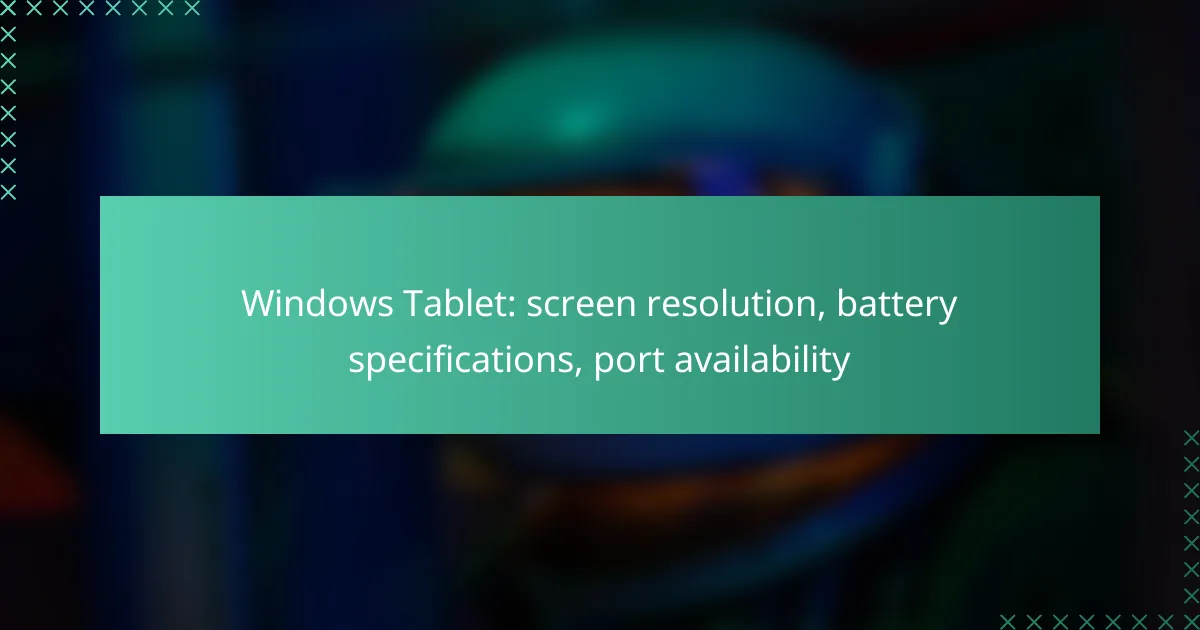Windows tablets offer a range of features that cater to both performance and usability, making them a versatile choice for users. With high-definition displays, models often boast resolutions starting at Full HD and extending to 4K for superior visual clarity. Battery specifications vary widely, influencing how long the device can be used on a single charge, while a selection of ports, including USB-C and HDMI, enhances connectivity options for various needs.
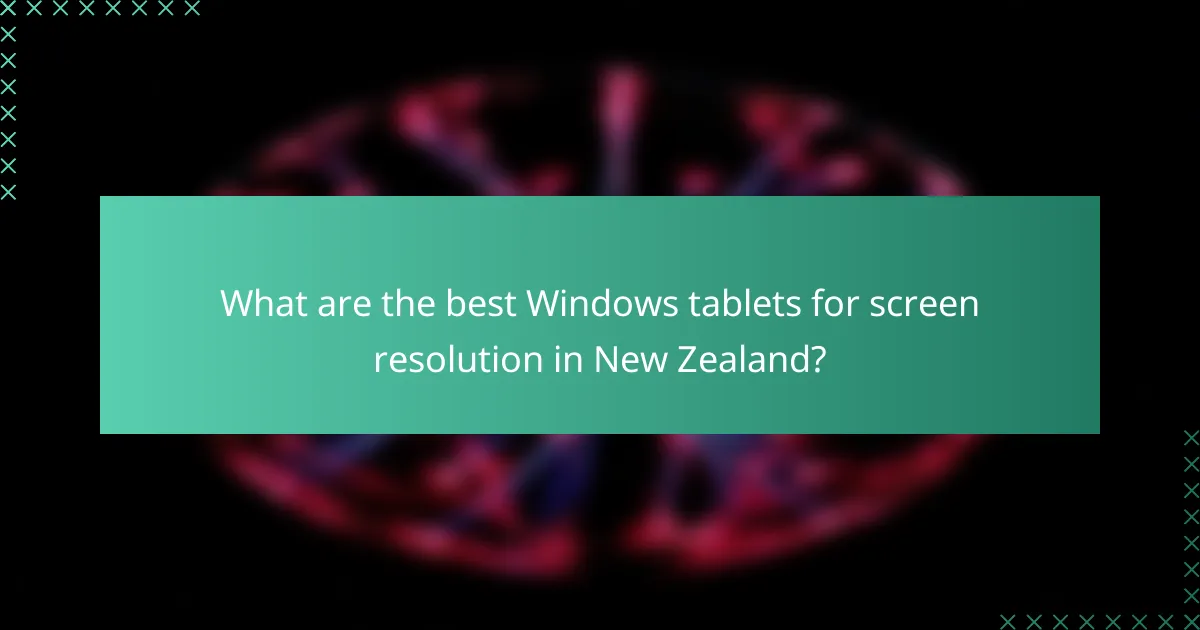
What are the best Windows tablets for screen resolution in New Zealand?
The best Windows tablets for screen resolution in New Zealand typically feature high-definition displays that enhance visual clarity and detail. Look for models with at least Full HD (1920 x 1080) resolution for a satisfactory experience, while higher resolutions like 4K (3840 x 2160) offer even sharper images.
Microsoft Surface Pro 9
The Microsoft Surface Pro 9 boasts a stunning PixelSense display with a resolution of 2880 x 1920, providing vibrant colors and sharp details. This tablet is ideal for creative professionals and anyone who values high-quality visuals.
With a 120Hz refresh rate, the Surface Pro 9 offers smooth scrolling and responsiveness, making it suitable for both work and entertainment. Consider the storage options and battery life, which can vary based on usage, to ensure it meets your needs.
Lenovo ThinkPad X12 Detachable
The Lenovo ThinkPad X12 Detachable features a 1920 x 1080 resolution display, which is adequate for most tasks, including office work and media consumption. Its IPS technology ensures good viewing angles and color accuracy, making it a reliable choice for professionals.
While the resolution is not as high as some competitors, the ThinkPad X12 excels in portability and battery life, often lasting a full workday. This makes it a practical option for users who prioritize functionality over ultra-high resolution.
HP Elite x2 G8
The HP Elite x2 G8 offers a resolution of 1920 x 1280, providing a decent balance between performance and visual quality. This tablet is designed for business users, featuring a durable build and a responsive touchscreen.
Its display is complemented by strong battery performance, typically lasting around 10 hours on a single charge. When considering the Elite x2 G8, evaluate its connectivity options and accessories, which can enhance your productivity on the go.
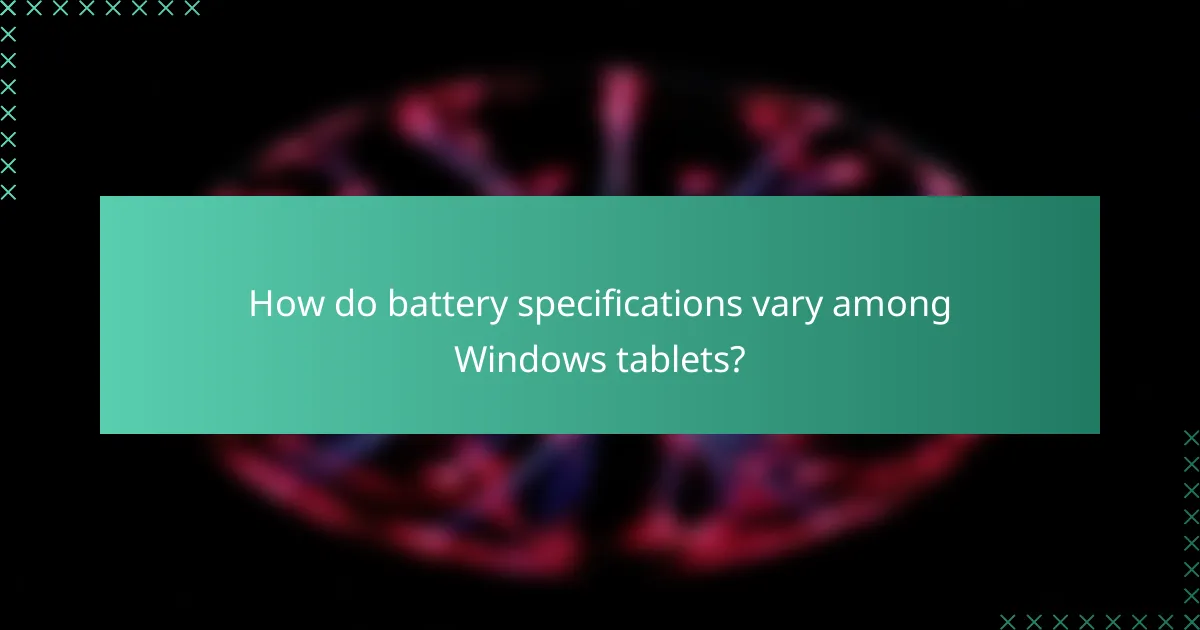
How do battery specifications vary among Windows tablets?
Battery specifications for Windows tablets can differ significantly, affecting overall performance and usability. Key factors include battery capacity, estimated usage time, and charging speed, which can vary by model and manufacturer.
Microsoft Surface Go 3 battery life
The Microsoft Surface Go 3 offers a battery life of around 10 hours under typical usage conditions, making it suitable for all-day use. Its 28 watt-hour battery is designed to support light productivity tasks and media consumption.
Users should consider that actual battery performance may vary based on usage patterns, such as running demanding applications or high screen brightness. To maximize battery life, adjusting settings and utilizing battery saver modes can be beneficial.
Acer Switch 7 Black Edition battery performance
The Acer Switch 7 Black Edition features a larger 48 watt-hour battery, providing approximately 8 to 10 hours of usage depending on the workload. This tablet is geared towards more intensive tasks, which can impact battery longevity.
For optimal battery performance, users should be mindful of resource-heavy applications and consider using power management features. Regularly updating drivers and software can also help maintain efficiency and extend battery life.
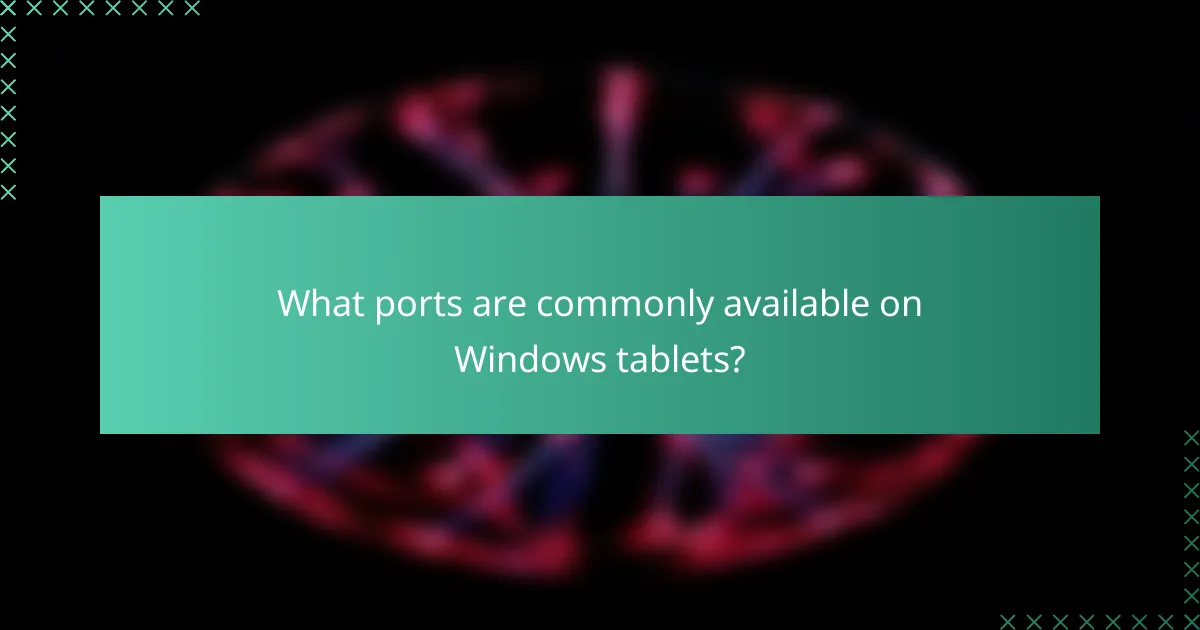
What ports are commonly available on Windows tablets?
Windows tablets typically feature a variety of ports that enhance connectivity and functionality. Common ports include USB-C, HDMI output, and MicroSD card slots, each serving distinct purposes for users.
USB-C ports
USB-C ports are increasingly standard on Windows tablets, providing versatile connectivity options. They support data transfer, video output, and charging, making them a valuable addition for users who need a single port for multiple functions.
When using USB-C, ensure that the cable and devices support the desired specifications, such as USB 3.1 for faster data transfer rates. Many peripherals, like external drives and docking stations, now utilize this port, streamlining your setup.
HDMI output
HDMI output allows users to connect their Windows tablets to external displays, such as monitors or TVs. This feature is essential for presentations, streaming media, or extending the tablet’s screen for multitasking.
Check if your tablet supports HDMI output directly or requires an adapter, as some models may only offer mini or micro HDMI ports. Using HDMI ensures high-quality video and audio transmission, making it ideal for entertainment or professional use.
MicroSD card slots
MicroSD card slots provide an easy way to expand storage on Windows tablets. This is particularly useful for users who need additional space for apps, media, or documents without relying solely on internal storage.
When selecting a MicroSD card, consider the speed class and capacity to ensure optimal performance. Cards with higher speed ratings (like UHS-I or UHS-II) can significantly improve loading times for applications and media files.
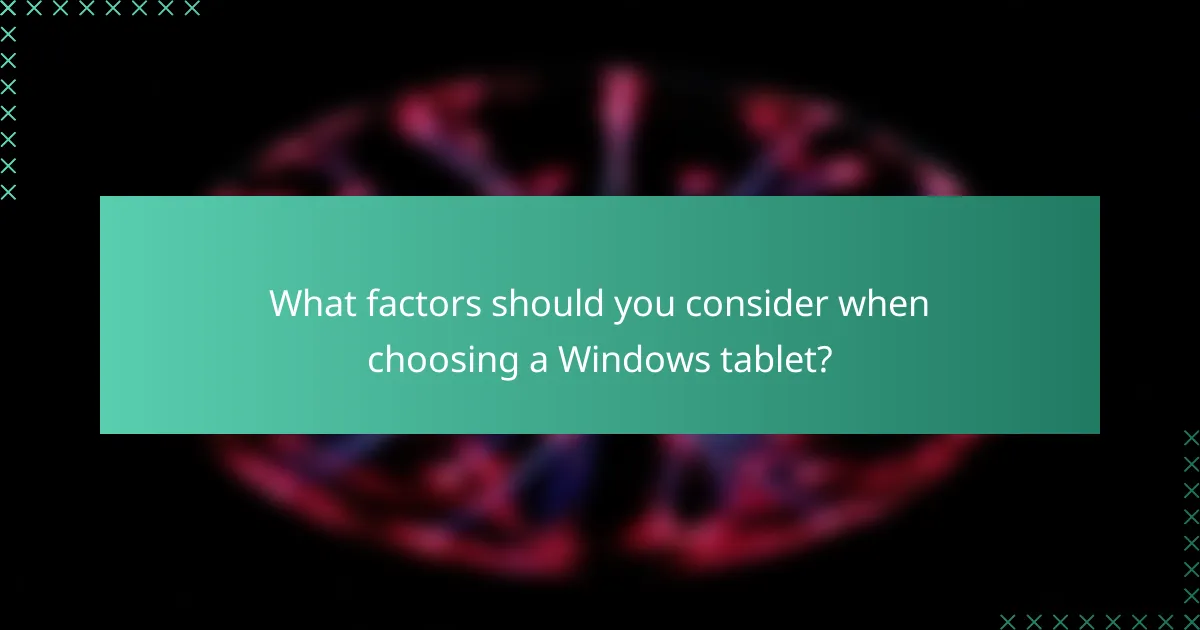
What factors should you consider when choosing a Windows tablet?
When selecting a Windows tablet, key factors include screen resolution, battery life, and port availability. These elements significantly impact usability, performance, and compatibility with your needs.
Screen resolution
Screen resolution determines the clarity and detail of the display. Common resolutions for Windows tablets range from HD (1280 x 800) to Full HD (1920 x 1080) and even higher for premium models, which can reach 4K (3840 x 2160).
For tasks like graphic design or video editing, a higher resolution is beneficial, while basic browsing and document editing may only require HD. Consider your primary use case when evaluating resolution options.
Battery life
Battery life is crucial for portability and usability. Most Windows tablets offer battery life ranging from around 6 to 12 hours, depending on usage and power settings.
To maximize battery life, look for tablets with energy-efficient processors and consider how you plan to use the device. Streaming video and gaming typically consume more power than simple tasks like word processing.
Port availability
Port availability affects connectivity and peripheral compatibility. Common ports on Windows tablets include USB-C, USB-A, HDMI, and headphone jacks.
Evaluate your needs for connecting external devices like monitors, keyboards, or storage. A tablet with multiple USB ports or a docking station option can enhance versatility, especially for professional use.
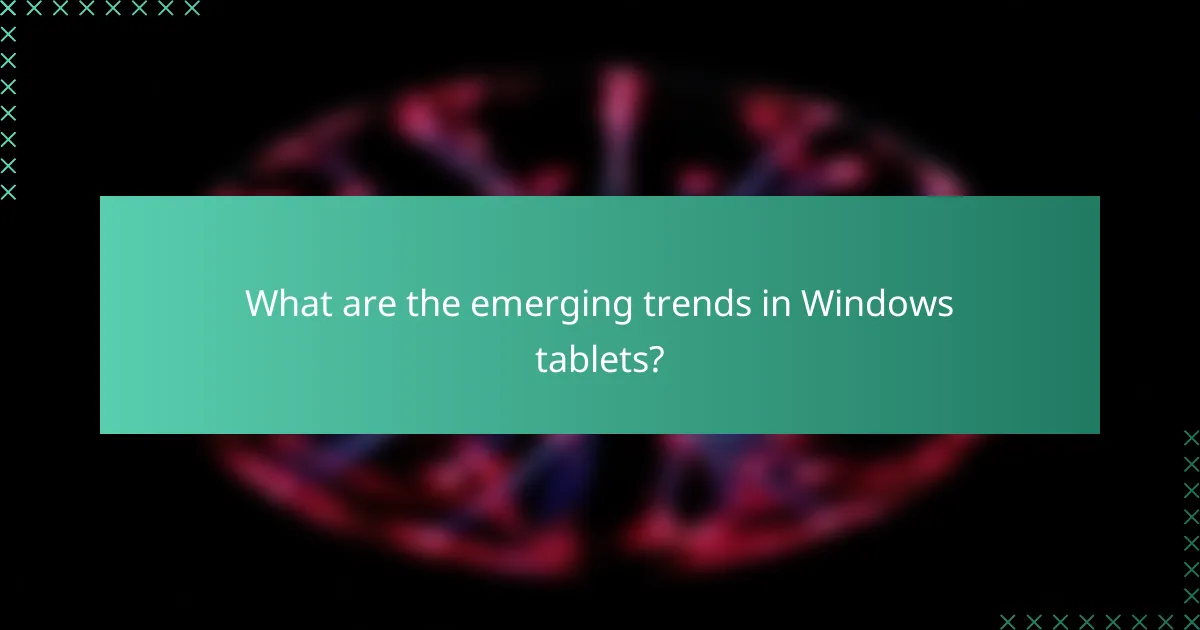
What are the emerging trends in Windows tablets?
Emerging trends in Windows tablets focus on enhancing user experience through better integration with cloud services, advancements in display technology, and improved battery efficiency. These developments aim to meet the growing demands for performance, portability, and connectivity in a mobile computing environment.
Increased integration with cloud services
Windows tablets are increasingly designed to work seamlessly with cloud services, allowing users to store and access data remotely. This integration facilitates real-time collaboration and ensures that files are always up-to-date across devices.
Popular cloud platforms like OneDrive and Google Drive are often pre-installed or easily accessible, making it simple for users to back up important documents and media. This trend not only enhances productivity but also reduces the need for extensive local storage.
Advancements in display technology
Recent advancements in display technology have significantly improved the visual quality of Windows tablets. Many models now feature high-resolution screens, such as Full HD or even 4K, which provide sharper images and better color accuracy for tasks like photo editing or media consumption.
Additionally, innovations like OLED and mini-LED displays enhance contrast and brightness, making screens more vibrant. Users should consider these features when selecting a tablet, as they can greatly impact the overall experience.
Improved battery efficiency
Battery efficiency in Windows tablets has seen notable improvements, with many devices now offering longer usage times on a single charge. Users can expect anywhere from 8 to 15 hours of battery life, depending on the model and usage patterns.
Manufacturers are employing advanced power management technologies and energy-efficient processors to extend battery life. When choosing a tablet, look for models that advertise low power consumption and fast charging capabilities to ensure they meet your daily needs.
